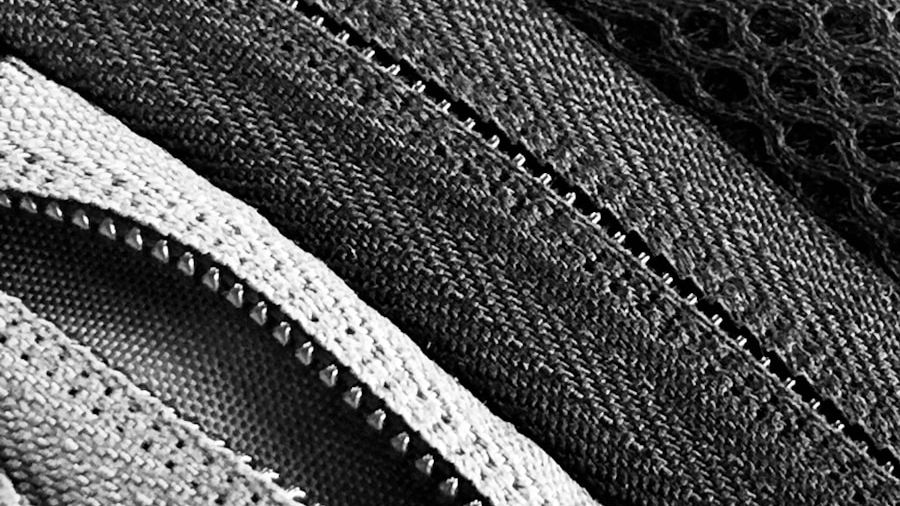The intersection of technology and sports has given rise to a new frontier in athletic performance enhancement: smart fabrics. These innovative materials are engineered to provide athletes with real-time data, improve comfort, and enhance overall performance. Smart fabrics are embedded with sensors and conductive fibers that can monitor various physiological parameters, such as heart rate, body temperature, and muscle activity.
This integration of technology into textiles not only revolutionizes how athletes train but also how they recover and prevent injuries. As the demand for performance optimization grows, smart fabrics are becoming an essential component of modern athletic gear. The allure of smart fabrics lies in their ability to transform traditional sportswear into high-tech performance enhancers.
Athletes can now wear clothing that not only fits well but also communicates vital information about their physical state. This capability allows for a more personalized training regimen, as athletes can adjust their workouts based on real-time feedback. The potential for smart fabrics to enhance athletic performance is vast, making them a focal point of research and development in the sports industry.
As we delve deeper into the evolution and impact of these materials, it becomes clear that smart fabrics are not just a passing trend but a significant advancement in the quest for athletic excellence.
Key Takeaways
- Smart fabrics have revolutionized athletic performance enhancement by integrating technology into clothing and equipment.
- The evolution of smart fabrics in sports has led to the development of advanced materials that can monitor and enhance athlete performance.
- Smart fabrics have a significant impact on athlete performance by providing real-time data and feedback to improve training and competition outcomes.
- These fabrics play a crucial role in injury prevention by providing support, protection, and monitoring capabilities to athletes during physical activities.
- The future of smart fabrics in athletic training and recovery looks promising, with advancements in technology aimed at improving recovery and overall athlete well-being.
The Evolution of Smart Fabrics in Sports
The journey of smart fabrics in the realm of sports began with the advent of basic wearable technology. Early iterations included simple heart rate monitors and pedometers that athletes could wear during training sessions. However, as technology advanced, so did the capabilities of these fabrics.
This evolution marked a significant shift from passive clothing to active performance-enhancing gear. In recent years, companies have invested heavily in research and development to create smart fabrics that are not only functional but also comfortable and stylish.
For instance, brands like Under Armour and Nike have pioneered the integration of moisture-wicking materials with embedded sensors that track biometric data. These advancements have led to the creation of garments that can monitor an athlete’s performance metrics without compromising on comfort or aesthetics. The evolution of smart fabrics has also been influenced by the growing interest in data analytics within sports, as coaches and trainers seek to leverage information to optimize training regimens and improve athlete outcomes.
The Impact of Smart Fabrics on Athlete Performance
The impact of smart fabrics on athlete performance is profound and multifaceted. By providing real-time feedback on various physiological metrics, these fabrics enable athletes to make informed decisions about their training and recovery strategies. For example, a runner wearing a smart shirt that monitors heart rate variability can adjust their pace based on their current cardiovascular state, potentially leading to improved endurance and performance during races.
This level of insight allows athletes to push their limits while minimizing the risk of overtraining. Moreover, smart fabrics can enhance performance through their ability to adapt to environmental conditions. Some advanced textiles are designed to regulate temperature by wicking away moisture or providing insulation when needed.
This adaptability ensures that athletes remain comfortable and focused during intense training sessions or competitions. Additionally, the integration of smart fabrics with mobile applications allows athletes to track their progress over time, setting benchmarks and goals based on data-driven insights. This combination of real-time monitoring and long-term tracking creates a comprehensive approach to performance enhancement that was previously unattainable.
The Role of Smart Fabrics in Injury Prevention
Injury prevention is a critical aspect of athletic training, and smart fabrics play a pivotal role in this domain. By continuously monitoring an athlete’s biomechanics and physiological responses, these advanced textiles can identify patterns that may indicate an increased risk of injury. For instance, smart compression garments equipped with sensors can analyze muscle strain and fatigue levels, alerting athletes when they need to modify their training intensity or take a break.
This proactive approach to injury prevention can significantly reduce the incidence of common sports injuries such as strains, sprains, and tendonitis. Furthermore, smart fabrics can facilitate rehabilitation by providing real-time feedback during recovery exercises. Athletes recovering from injuries can wear garments that monitor their movements and ensure they are performing rehabilitation exercises correctly.
This feedback loop not only enhances the effectiveness of rehabilitation programs but also instills confidence in athletes as they return to their sport. The ability to prevent injuries before they occur and support recovery processes represents a transformative shift in how athletes approach their training regimens.
The Future of Smart Fabrics in Athletic Training and Recovery
Looking ahead, the future of smart fabrics in athletic training and recovery appears promising, with ongoing advancements poised to further enhance their capabilities. Researchers are exploring the integration of artificial intelligence (AI) with smart fabric technology, enabling garments to learn from an athlete’s performance data over time. This could lead to personalized training recommendations based on an individual’s unique physiological responses and performance history.
Such tailored approaches could optimize training efficiency and effectiveness, allowing athletes to reach their peak potential. Moreover, the potential for smart fabrics to facilitate recovery is expanding as well. Innovations such as electrostimulation technology embedded within textiles could aid muscle recovery by promoting blood circulation and reducing soreness post-exercise.
Additionally, advancements in materials science may lead to the development of fabrics that can actively respond to an athlete’s needs—such as adjusting compression levels based on muscle fatigue or temperature regulation based on environmental conditions. As these technologies continue to evolve, smart fabrics will likely become indispensable tools for athletes seeking to enhance their training and recovery processes.
Advancements in Smart Fabric Technology for Athletic Performance Enhancement
Recent advancements in smart fabric technology have opened new avenues for enhancing athletic performance. One notable development is the incorporation of nanotechnology into textiles, which allows for the creation of ultra-thin sensors that can be woven directly into fabric without compromising its flexibility or comfort. These nanofibers can detect minute changes in muscle activity or body temperature, providing athletes with precise data that can inform their training decisions.
Additionally, the rise of wireless communication technologies has enabled seamless data transmission from smart fabrics to mobile devices or cloud-based platforms. This connectivity allows athletes and coaches to access real-time analytics during training sessions or competitions, facilitating immediate adjustments based on performance metrics. Furthermore, advancements in battery technology have led to longer-lasting power sources for these embedded sensors, ensuring that athletes can rely on their smart garments throughout extended training periods or events without interruption.
The Integration of Smart Fabrics in Sports Apparel and Equipment
The integration of smart fabrics into sports apparel and equipment is becoming increasingly prevalent across various athletic disciplines. From running shoes equipped with pressure sensors that analyze gait mechanics to cycling jerseys that monitor heart rate and breathing patterns, the applications are diverse and impactful. Major sports brands are collaborating with tech companies to create innovative products that cater to the specific needs of athletes while leveraging cutting-edge technology.
For instance, some basketball jerseys now feature integrated sensors that track player movements on the court, providing coaches with valuable insights into player performance during games. Similarly, swimwear designed with smart fabrics can measure stroke efficiency and body position in water, offering swimmers data that can help refine their technique. As these integrations become more sophisticated, they not only enhance individual athlete performance but also contribute to team strategies by providing coaches with comprehensive analytics.
Challenges and Opportunities for Smart Fabrics in the Athletic Industry
Despite the promising advancements in smart fabric technology, several challenges remain for widespread adoption within the athletic industry.
While prices have been decreasing as technology matures, many consumers may still find smart apparel prohibitively expensive compared to traditional sportswear options.
This cost barrier could limit accessibility for amateur athletes or those at lower levels of competition. Additionally, there are concerns regarding data privacy and security as more athletes rely on connected devices for performance tracking. Ensuring that sensitive biometric data is protected from unauthorized access is paramount for both manufacturers and consumers alike.
However, these challenges also present opportunities for innovation within the industry. As demand for smart fabrics grows, companies have the chance to develop more affordable solutions while addressing privacy concerns through robust security measures. In conclusion, while challenges exist, the potential for smart fabrics to revolutionize athletic performance enhancement is undeniable.
As technology continues to advance and integrate into sportswear, athletes will benefit from improved training methodologies, enhanced injury prevention strategies, and optimized recovery processes—ultimately leading to a new era in athletic excellence.
In a related article, How One Founder Realized the Potential of Sustainable Energy, the focus shifts to the innovative ways in which entrepreneurs are harnessing sustainable energy sources to create a more environmentally friendly future. Just as smart fabrics are revolutionizing athletic performance enhancement, sustainable energy solutions are transforming the way we power our world. Both articles highlight the importance of technological advancements in improving our daily lives and shaping a more sustainable future.
FAQs
What are smart fabrics?
Smart fabrics are textiles that have been designed and manufactured to include technologies that provide added functionality, such as monitoring and transmitting data, regulating temperature, or providing protection from environmental elements.
How are smart fabrics being used in athletic performance enhancement?
Smart fabrics are being used in athletic performance enhancement by providing features such as moisture-wicking, temperature regulation, and biometric monitoring. These features can help athletes stay comfortable, perform better, and reduce the risk of injury.
What are some examples of smart fabrics used in athletic performance enhancement?
Examples of smart fabrics used in athletic performance enhancement include moisture-wicking fabrics that keep athletes dry, temperature-regulating fabrics that help maintain optimal body temperature, and biometric monitoring fabrics that track heart rate, breathing, and other vital signs.
What are the potential benefits of using smart fabrics in athletic performance enhancement?
The potential benefits of using smart fabrics in athletic performance enhancement include improved comfort and performance, reduced risk of injury, and the ability to track and analyze biometric data to optimize training and recovery.
What are the challenges and limitations of smart fabrics in athletic performance enhancement?
Challenges and limitations of smart fabrics in athletic performance enhancement include cost, durability, and the need for reliable and accurate data collection and analysis. Additionally, integrating smart fabric technologies into existing athletic apparel and equipment can be complex.



